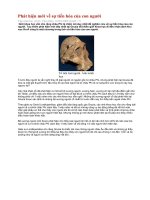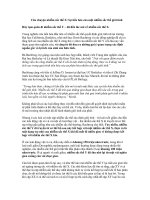Sự tiến hóa nucleic acids
Bạn đang xem bản rút gọn của tài liệu. Xem và tải ngay bản đầy đủ của tài liệu tại đây (1.44 MB, 36 trang )
Nucleic Acids
•
Nucleic acids are molecules that store information for cellular
growth and reproduction
•
There are two types of nucleic acids:
- deoxyribonucleic acid (DNA) and ribonucleic acid (RNA)
•
These are polymers consisting of long chains of monomers called
nucleotides
•
A nucleotide consists of a nitrogenous base, a pentose sugar and a
phosphate group:
Nitrogen Bases
•
The nitrogen bases in nucleotides consist of two general types:
- purines: adenine (A) and guanine (G)
- pyrimidines: cytosine (C), thymine (T) and Uracil (U)
Pentose Sugars
•
There are two related pentose sugars:
- RNA contains ribose
- DNA contains deoxyribose
•
The sugars have their carbon atoms numbered with primes
to distinguish them from the nitrogen bases
Nucleosides and Nucleotides
•
A nucleoside consists of a nitrogen base linked by a glycosidic
bond to C1’ of a ribose or deoxyribose
•
Nucleosides are named by changing the the nitrogen base
ending to -osine for purines and –idine for pyrimidines
•
A nucleotide is a nucleoside that forms a phosphate ester with
the C5’ OH group of ribose or deoxyribose
•
Nucleotides are named using the name of the nucleoside
followed by 5’-monophosphate
Names of Nucleosides and Nucleotides
AMP, ADP and ATP
•
Additional phosphate groups can be added to the nucleoside 5’-
monophosphates to form diphosphates and triphosphates
•
ATP is the major energy source for cellular activity
Primary Structure of Nucleic Acids
•
The primary structure of a nucleic acid is the nucleotide sequence
•
The nucleotides in nucleic acids are joined by phosphodiester bonds
•
The 3’-OH group of the sugar in one nucleotide forms an ester bond
to the phosphate group on the 5’-carbon of the sugar of the next
nucleotide
Reading Primary Structure
•
A nucleic acid polymer has a free
5’-phosphate group at one end and a
free 3’-OH group at the other end
•
The sequence is read from the free
5’-end using the letters of the bases
•
This example reads
5’—A—C—G—T—3’
Example of RNA Primary Structure
•
In RNA, A, C, G, and U are linked by 3’-5’ ester bonds
between ribose and phosphate
Example of DNA Primary Structure
•
In DNA, A, C, G, and T are linked by 3’-5’ ester bonds
between deoxyribose and phosphate
Secondary Structure: DNA Double Helix
•
In DNA there are two strands of nucleotides that wind together
in a double helix
- the strands run in opposite directions
- the bases are are arranged in step-like pairs
- the base pairs are held together by hydrogen bonding
•
The pairing of the bases from the two strands is very specific
•
The complimentary base pairs are A-T and G-C
- two hydrogen bonds form between A and T
- three hydrogen bonds form between G and C
•
Each pair consists of a purine and a pyrimidine, so they are the
same width, keeping the two strands at equal distances from
each other
Base Pairing in the DNA Double Helix
Storage of DNA
•
In eukaryotic cells (animals, plants, fungi) DNA is stored in
the nucleus, which is separated from the rest of the cell by a
semipermeable membrane
•
The DNA is only organized into chromosomes during cell
replication
•
Between replications, the DNA is stored in a compact ball
called chromatin, and is wrapped around proteins called
histones to form nucleosomes
DNA Replication
•
When a eukaryotic cell divides, the process is called mitosis
- the cell splits into two identical daughter cells
- the DNA must be replicated so that each daughter cell has a copy
•
DNA replication involves several processes:
- first, the DNA must be unwound, separating the two strands
- the single strands then act as templates for synthesis of the new
strands, which are complimentary in sequence
- bases are added one at a time until two new DNA strands that
exactly duplicate the original DNA are produced
•
The process is called semi-conservative replication because
one strand of each daughter DNA comes from the parent DNA and
one strand is new
•
The energy for the synthesis comes from hydrolysis of phosphate
groups as the phosphodiester bonds form between the bases
Semi-Conservative DNA Replication
Direction of Replication
•
The enzyme helicase unwinds several sections of parent DNA
•
At each open DNA section, called a replication fork, DNA
polymerase catalyzes the formation of 5’-3’ester bonds of the
leading strand
•
The lagging strand, which grows in the 3’-5’ direction, is
synthesized in short sections called Okazaki fragments
•
The Okazaki fragments are joined by DNA ligase to give a
single 3’-5’ DNA strand
Enzymes and Proteins Involved in DNA Replication
Ribonucleic Acid (RNA)
•
RNA is much more abundant than DNA
•
There are several important differences between RNA and DNA:
- the pentose sugar in RNA is ribose, in DNA it’s deoxyribose
- in RNA, uracil replaces the base thymine (U pairs with A)
- RNA is single stranded while DNA is double stranded
- RNA molecules are much smaller than DNA molecules
•
There are three main types of RNA:
- ribosomal (rRNA), messenger (mRNA) and transfer (tRNA)
Types of RNA
Ribosomal RNA and Messenger RNA
•
Ribosomes are the sites of protein synthesis
- they consist of ribosomal DNA (65%) and proteins (35%)
- they have two subunits, a large one and a small one
•
Messenger RNA carries the genetic code to the ribosomes
- they are strands of RNA that are complementary to the DNA
of the gene for the protein to be synthesized
Transfer RNA
•
Transfer RNA translates the genetic code from the messenger RNA
and brings specific amino acids to the ribosome for protein synthesis
•
Each amino acid is recognized by one or more specific tRNA
•
tRNA has a tertiary structure that is L-shaped
- one end attaches to the amino acid and the other binds to the mRNA
by a 3-base complimentary sequence
Protein Synthesis
•
The two main processes involved in protein synthesis are
- the formation of mRNA from DNA (transcription)
- the conversion by tRNA to protein at the ribosome (translation)
•
Transcription takes place in the nucleus, while translation takes
place in the cytoplasm
•
Genetic information is transcribed to form mRNA much the same
way it is replicated during cell division
Transcription
•
Several steps occur during transcription:
- a section of DNA containing the gene unwinds
- one strand of DNA is copied starting at the initiation point,
which has the sequence TATAAA
- an mRNA is synthesized using complementary base pairing
with uracil (U) replacing thymine (T)
- the newly formed mRNA moves out of the nucleus to
ribosomes in the cytoplasm and the DNA re-winds
RNA Polymerase
•
During transcription, RNA polymerase moves along the DNA
template in the 3’-5’direction to synthesize the corresponding
mRNA
•
The mRNA is released at the termination point
Processing of mRNA
•
Genes in the DNA of eukaryotes contain exons that code
for proteins along with introns that do not
•
Because the initial mRNA, called a pre-RNA, includes
the noncoding introns, it must be processed before it can be
read by the tRNA
•
While the mRNA is still in the nucleus, the introns are
removed from the pre-RNA
•
The exons that remain are joined to form the mRNA that
leaves the nucleus with the information for the synthesis of
protein









